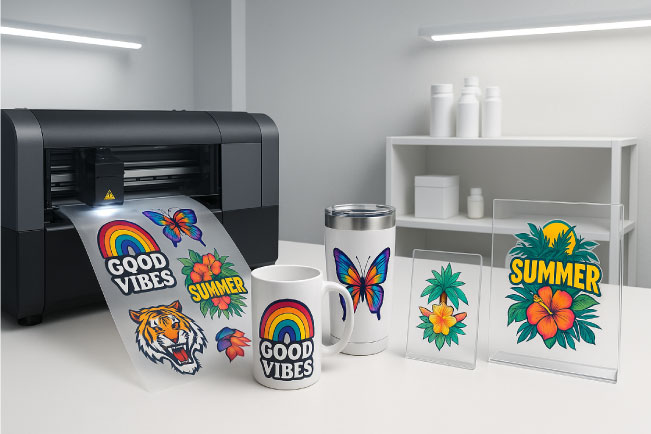Why UV Direct to Film Transfers Are Changing the Printing Industry
The custom printing industry has seen many innovations over the years—screen printing, sublimation, heat transfer vinyl, and direct-to-garment (DTG) printing have all had their moment. But in recent years, UV Direct to Film Transfers have emerged as one of the most exciting, versatile, and profitable printing methods available.
For businesses that thrive on offering high-quality, durable, and unique products, UV DTF transfers are more than just another printing technique—they’re a game-changer. This method allows you to print detailed, vibrant designs that can be applied to almost any surface, from glass and acrylic to leather and wood, without the need for heat.
In this comprehensive guide, we’ll explore every benefit of UV Direct to Film Transfers, from the technology behind them to their business impact, and explain why now is the perfect time to add UV DTF printing to your production lineup.
Understanding UV Direct to Film Printing
Before diving into the benefits, let’s break down what UV Direct to Film printing actually is and how it works.
UV DTF printing involves using a UV printer to print a design onto a special PET transfer film using UV-curable inks. The printer often lays down ink in multiple layers—CMYK for color, white for opacity, and varnish for a glossy or matte finish—while curing each layer instantly with ultraviolet light.
The printed transfer is then coated with an adhesive layer, making it ready to be applied to virtually any smooth, non-porous surface. Unlike traditional heat transfers, UV DTF designs are applied using light pressure rather than high heat, making it safe for heat-sensitive materials.
Key Components of UV DTF Transfers
- PET Film – The medium that holds your printed design until transfer.
- UV-Curable Ink – Ink that instantly hardens under UV light, producing vivid and long-lasting colors.
- Adhesive Layer – Ensures the print bonds securely to the target surface.
- Cold Peel Application – Allows easy transfer without heat.
Versatility: Printing Beyond Apparel
One of the biggest benefits of UV Direct to Film transfers is that they break the limitations of traditional printing. While sublimation requires polyester fabrics and heat transfer vinyl works best on garments, UV DTF transfers can be applied to almost any surface.
Surfaces compatible with UV DTF transfers include:
- Glass – Mugs, glassware, windows, awards.
- Acrylic – Keychains, signage, display plaques.
- Metal – Tumblers, license plates, promotional signs.
- Wood – Decorative plaques, ornaments, custom coasters.
- Leather – Wallets, belts, journals, handbags.
- Plastic – Phone cases, water bottles, product packaging.
This opens the door for product diversification—instead of being limited to T-shirts and hoodies, you can produce custom home décor, promotional items, corporate gifts, and more.
Business Impact:
Offering more products means you can reach new markets, cater to more customer requests, and increase your revenue streams without investing in multiple printing systems.
Exceptional Print Quality and Color Accuracy
When it comes to custom products, print quality matters—a lot. UV DTF printing delivers sharp, detailed, and vibrant designs that rival, and often surpass, other printing methods.
Why UV DTF print quality stands out:
- High DPI Printing – Many UV printers achieve resolutions of 1440 DPI or higher, capturing fine details and small text.
- Layered Printing – Ability to print color + white ink + varnish for added texture and depth.
- Gloss and Matte Finishes – Adds a professional, premium appearance.
- Perfect Color Matching – Consistent results across batches, making it ideal for branding.
This means logos look crisp, photos maintain their sharpness, and even the most intricate patterns come through beautifully.
Durability That Lasts Years
One of the standout benefits of UV Direct to Film transfers is their incredible durability. The UV-curable ink bonds tightly to the surface, resisting scratches, fading, and water damage.
Durability advantages include:
- UV Resistance – Colors won’t fade quickly, even with outdoor exposure.
- Scratch Resistance – Perfect for everyday-use items like mugs and tumblers.
- Waterproof – Safe for dishwashing and outdoor use.
- Chemical Resistance – Less likely to be damaged by cleaning products.
For customers, this means they get products that look great for years, and for your business, it means fewer returns and higher customer satisfaction.
No Heat Required: Protecting Delicate Surfaces
Unlike sublimation or HTV, which require heat presses at 300–400°F, UV DTF transfers use a cold peel method. You simply apply the design with light pressure and peel away the film—no heat required.
Why this matters:
- Works on heat-sensitive materials like certain plastics, leathers, or coated metals.
- No risk of warping or melting.
- Easier and faster production process.
This makes UV DTF transfers especially useful for customizing pre-made products that could be damaged by high temperatures.
Speed and Efficiency in Production
Time is money—especially in the printing business. UV DTF transfers can dramatically reduce turnaround times because the UV light cures the ink instantly, meaning the transfer is ready to apply right after printing.
Efficiency benefits:
- No drying time needed.
- Ability to print and apply on the same day.
- Faster fulfillment for urgent orders.
- Streamlined workflow for bulk production.
For print-on-demand businesses, this speed is a huge competitive advantage.
Cost-Effective for Both Small and Large Orders
Traditional printing methods like screen printing are cost-effective only for large runs because of the setup involved. UV DTF printing eliminates that barrier.
Cost advantages:
- Low Minimum Orders – Perfect for personalized, one-off items.
- No Screen or Plate Setup – Cuts preparation costs.
- Minimal Material Waste – Only print what you need.
- One Printer, Many Products – Reduces the need for multiple machines.
This flexibility makes UV Direct to Film transfers ideal for both custom gift shops and large-scale promotional product companies.
Environmentally Friendly Printing Option
Many customers—and businesses—are prioritizing sustainability. UV DTF transfers are eco-friendlier than some traditional methods.
Eco benefits include:
- Low VOC Inks – UV-curable inks contain fewer harmful chemicals.
- No Harsh Solvents – Safer for your workspace.
- Less Waste – No need for excess materials.
- Lower Energy Use – No heat press required.
If you market your business as environmentally conscious, UV DTF printing can strengthen your brand image.
Expanding Your Market Opportunities
Because UV DTF printing works on such a wide range of materials, you can target different industries and niches, including:
- Weddings – Custom favors, table décor, signage.
- Corporate Branding – Promotional giveaways, office décor.
- Sports Teams – Branded gear, trophies, and awards.
- Etsy and Craft Markets – Personalized gifts and décor.
- Fundraisers – Branded merchandise for events.
Diversifying your offerings reduces your risk and helps maintain steady sales even when one product category slows down.
A Competitive Edge in a Crowded Market
In today’s competitive custom printing landscape, having UV Direct to Film transfer capability sets you apart. Customers will come to you for products they simply can’t get from printers who only offer shirts or mugs.
Competitive advantages:
- Unique product range.
- Premium finishes competitors can’t match.
- Ability to fulfill complex orders quickly.
- Long-lasting results that boost repeat business.
Best Practices for Using UV DTF Transfers
To get the most from UV DTF printing, follow these tips:
- Invest in Quality Film – Cheap film can cause adhesion issues.
- Calibrate Colors – Maintain consistency for branding clients.
- Test Surfaces – Ensure proper adhesion before mass production.
- Store Transfers Properly – Keep them in a dry, dust-free environment.
Why Your Business Should Invest in UV Direct to Film Transfers
The benefits of UV Direct to Film transfers go beyond just producing pretty prints—they expand your product range, improve durability, speed up production, and help you tap into new markets.
Whether you’re a small business owner looking to diversify or a large-scale printing company aiming for greater efficiency, UV DTF printing offers a versatile, cost-effective, and future-proof solution.
With its vibrant colors, unmatched durability, eco-friendly appeal, and incredible versatility, it’s no wonder that UV Direct to Film transfers are quickly becoming the go-to choice for modern printing businesses.

